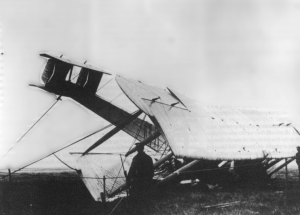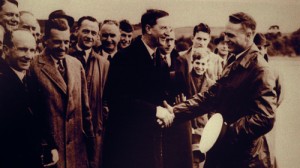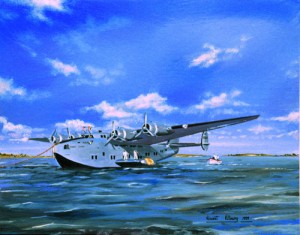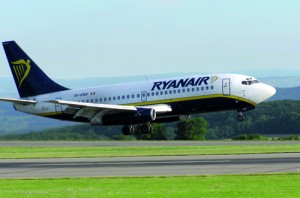PIONEERS AND AVIATORS: A CENTURY OF IRISH AVIATION
Published in Issue 3 (May/June 2014), Reviews, Volume 22
The documentary began with the landing of Alcock and Brown in Roundstone bog in 1919 after completing the first transatlantic flight from North America to Europe.
Is Ireland traditionally associated with a particular mode of transport? Britain, after all, will always be associated with the seafaring prowess that laid the military and economic foundations for global dominance, and the very existence (not to mention influence) of the United States in its current form is inextricable from the development of the automobile. But what about the small island in between? Pioneers and aviators was a two-part documentary that made the case for linking Ireland to another way of getting from A to B: aviation.
It should be noted from the outset that Pioneers and aviators was produced by Newgrange Pictures with the support of the industry it depicts—specifically the international aircraft-leasing group Avolon (whose head office is located in Ballsbridge). It also came with some big names attached: it was directed by the award-winning Irish director Alan Gilsenan, was narrated by Seán McGinley and was accompanied by a score by Mícheál Ó Súilleabháin working with the RTÉ Concert Orchestra, redolent of Seán Ó Riada’s famous score for Mise Éire.

Eamon de Valera greets the American aviator Charles Lindbergh at Foynes, Co. Limerick, the ‘port’ chosen (with his assistance) for flying boats in the 1930s. (Foynes Flying Boat Museum)
Pioneers and aviators was presumably intended to pack a punch and told its story reasonably well, but committed some striking sins of omission as it did so. It began, naturally, at the beginning, with the landing of Alcock and Brown in Roundstone bog in 1919 after completing the first transatlantic flight from North America to Europe. There was an impressionistic feel to the early sections of the first episode: alongside Alcock and Brown there was the tale of how Michael Collins kept an aircraft on hand in London during the treaty negotiations in 1921 lest the talks break down and a swift exit be required. Alongside these, it would have been interesting to hear of how the British deployed air power during the Irish revolution, or even the story of Douglas ‘Wrong Way’ Corrigan, who ‘accidentally’ ended up in Baldonnell in 1938, having left Brooklyn to fly to California after permission for a transatlantic flight was denied by the US authorities (see HI 16.5, Sept./Oct. 2008, pp 6–7).

A painting of the Boeing B.314 Yankee Clipper, which landed at Foynes on 9 July 1939 to complete the first commercial passenger flight on a direct route between the USA and Europe. (Vincent Killowry)
The 1921 treaty did, however, open up a potential opportunity for the emergent Free State. Amidst its provisions there were no strictures imposed on airspace and aviation. Ireland’s geographical location made it a natural gateway between Europe and North America: cue an extended and fascinating section on the development in the 1930s of the ‘port’ for flying boats at Foynes on the Shannon estuary, a crucial link in the earliest transatlantic routes. The site was chosen with the assistance of Charles Lindbergh; alongside the glamour of a small town in County Limerick having a direct link to New York, it became something of a centre of intrigue during the Second World War, as the first landfall before occupied Europe was in a neutral state. But the more concrete contribution of the endeavour at Foynes was that it offered proof that Ireland could compete internationally (which also offered a clue to the trajectory of the rest of the series). Foynes was the ancestor of Shannon airport, originally developed to exploit the fact that in the post-war world the US didn’t want transit points for its airlines to be based in the UK. The terms of the ‘Shannon stopover’ were advantageous to the Irish, ensuring that the first episode of Pioneers and aviators ended on a broadly positive note amidst the optimism of the 1960s.
But if the first episode was interesting, the second was eminently forgettable. At the heart of it was the ambitious vision and impressive legacy of the late Tony Ryan. While working for Aer Lingus, Ryan was faced with the consequences of the economic downturn of the 1970s, which was exacerbated in Ireland by the detrimental impact of the Troubles on tourism. Aer Lingus thus had a substantial portion of its fleet grounded, and Ryan was tasked with leasing out these aircraft. From this new venture came the creation by Ryan of Guinness Peat Aviation (GPA), one of the few Irish global success stories of the 1970s and 1980s. The reluctance of the US to go along with the Shannon stopover into perpetuity led to the courting of the Soviet carrier, Aeroflot, but the visibility of the Soviet aircraft at Shannon might be contrasted with the huge and largely obscure venture pioneered by GPA. Aircraft-leasing remains a major Irish industry but one that, given the nature of its global trade, is far less visible than it might otherwise be. GPA was a genuinely innovative venture that thought big and traded in the tangible (better than simply selling houses to one another). It was, however, derailed by a disastrous stock flotation in 1992; the remnants were bought by General Electric but Ryan’s legacy remains in the form of Ryanair.

he second episode focused on the ambitious vision of Tony Ryan, whose legacy remains in the form of Ryanair. Surprisingly, there was no probing of the revolutionary implications of cheap air travel as pioneered in Europe by the airline.
Surprisingly, there was no probing of the revolutionary implications of cheap air travel as pioneered in Europe by Ryanair (Michael O’Leary was a notable absentee). Even aside from stripping air travel of a sense of privilege and forcing other carriers (such as Aer Lingus, which was deeply hostile to this upstart) to cut costs, what impact did Ryanair have during the era of the ‘Celtic Tiger’ by making it possible to travel more extensively and cheaply than before? Such questions, let alone answers, were absent in an episode that rarely strayed beyond the boardroom. And this was the series’ undoing. Bernice Harrison, reviewing the second episode in The Irish Times (1 March 2014), noted that ‘too much of the second part felt like a comprehensive if workmanlike corporate video’. It is difficult to disagree. Nevertheless, it told an intriguing story, even if it did not make the most of it; the focus on the commanding heights of one section of the industry left out the relevance of it to those consumers who made up the largest cohort of beneficiaries.
John Gibney is on-line editor of History Ireland and of the Decade of Centenaries website,
www.decadeofcentenaries.com.
















